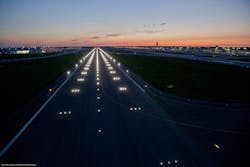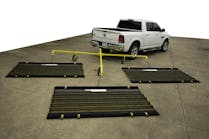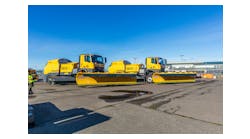They say switching from traditional light sources to the latest in Light Emitting Diode (LED) technology is like going from night to day…and that’s a significant understatement. Recently, a pilot on final approach into Ohio’s Port Columbus International Airport (CMH) was asked to contact the tower when he had the airport in sight. His response: “Not a problem, we’ve had it in sight since about Pittsburgh.” An exaggeration, sure, but LED airfield lighting visually appears brighter, lasts longer, is less expensive to maintain and provides a wider margin of safety than the older units it is steadily replacing. And, it is becoming less expensive on the front-end, too.
With its lighting expertise readily displayed at more than 2,000 airports around the world, ADB Airfield Solutions is a recognized leader in bringing LED systems to the airfield. While engineers and designers have readily recognized the virtue of the LED, it has progressed more slowly with airport designers and managers. Why? Retrofitting an airport with a completely new system not only takes a significant investment in cash, it takes time and often requires shifting the use of runways and other critical access points. Bottom line, it isn’t easy – and it isn’t cheap.
But, it is getting easier and the overall cost and time commitments are going down. The rewards from increasing airport safety, easier maintenance and reduced operating costs are overcoming the concerns for downtime and inconvenience.
What makes it truly different?
LED lighting may require different fixtures than its conventional counterparts and operates with much less demand for electrical power, but it can also use much of the airfield’s existing equipment. “An existing installation can be converted in about two months without shutting down a runway for the entire time,” explains Corey Stutz ADB’s marketing and business development manager. “In many cases, most of the underground infrastructure can be used with LED.”
“The new LED lights from ADB went online in late August 2013 when we officially commissioned our new South runway,” explains Tim Mentel, project manager for Port Columbus International Airport (CMH). “We went with LED for the new runway, for an assortment of reasons,” he adds. “We expect the LEDs to provide significant energy savings, while providing an environmentally-friendly (reducing our carbon footprint, etc.) solution and a great deal more and better visibility. LED technology can make an airport safer, especially in marginal weather conditions.”
“The LED lights provide a brighter more true color, it seems, over older lights, which have a softer feel,” observes a veteran corporate pilot. “And, I think the safety factor is greatly enhanced for ground operations. When you are taxiing in low weather or ground fog, the LED lights provide a crisp contrast between the blue of taxiway edge lights, the green of taxiway center-line lights and the white of runway edge lights. The older lights can appear more hazy during low weather operations and can require a higher level of concentration from the pilot,” he continues.
“In marginal weather an LED system allows for greater visibility and better situational awareness, all of which enhances safety,” he concludes.
Getting much more for less
“With the new runway we replaced all the controls and power sources to accommodate the LED technology and added lighting that we never had before,” adds Mentel, “including new in-pavement lighting on the centerline and touchdown areas.”
For the control systems in its electrical vault area, CMH went with ADB Constant Current Regulators (CCR) in stackable cabinets because they are easy to access and, by stacking them, the overall footprint is smaller allowing more to be put in a limited space.
“We are currently using less space for these systems even though we have more lights on the circuit already. We’re rebuilding the old South runway into an expanded taxiway and there will be additional LED lighting there, too,” explains Mentel. “When we’re done, about a year from now, our whole South airfield will be LED. And, even with all the new lights, we’re projecting that we can realize a 90 percent savings in energy costs alone, on top of savings in maintenance costs, bulbs and everything associated with the older technology.”
Ever-conscious of the demands for increased safety and efficiency balanced by budgetary restraints, ADB has partnered with Rittal Corporation, a world-wide market leader in its own right, to develop a new enclosure system incorporating the latest in ADB power sources with Rittal’s enclosure design. The Rittal cabinets for the CCR, using snap-in assembly techniques and easy to configure mounting panels and rails, have allowed ADB to significantly reduce the time it takes to prepare each unit for delivery. Being able to reduce manufacturing time and delivery, as well as installation time has made it possible to provide a more robust product quicker.
“Design innovations that help them go together faster in the beginning also make it possible for on-site maintenance to be done with less downtime,” adds mechanical engineering manager John Hesch. “And that’s a huge selling point.” A sentiment echoed by Mentel at CMH.
The new design provides smoother and more efficient assembly for ADB for a variety of reasons, not the least of which is that the Rittal mounting panel is zinc-plated, not painted, so all elements on it are immediately grounded. “We had to scrape paint off our older style panels to provide for grounding,” explains Hesch, “and not doing that saves a lot of time. And, with the snap-in assembly putting the panel in places is much quicker – two snaps on the bottom, pivot for two snaps on the top corners plus two screws and it’s done,” he adds.
The latest ADB products are moving more and more toward a total modular design. These CCRs are available with 3 or 5 precision output levels. The Rittal enclosures follow suit with door options to accommodate differing monitoring units. “While LED systems may require smaller power sources, the new enclosures will accept much larger cores as well, giving us the versatility we need as new products develop,” points out Hesch.
The new CCR units move quickly through the assembly line on the same pallet they are shipped in on – Rittal bolts them to the shipping unit so there are no straps – and the pallets, corner protectors and other packaging can be reused for shipping to the next installation.
Nearly 1,000 of the new CCR models were sold for installations in 2013 as the demand for safer, more efficient airport lighting grows and LED technology grows with it.






